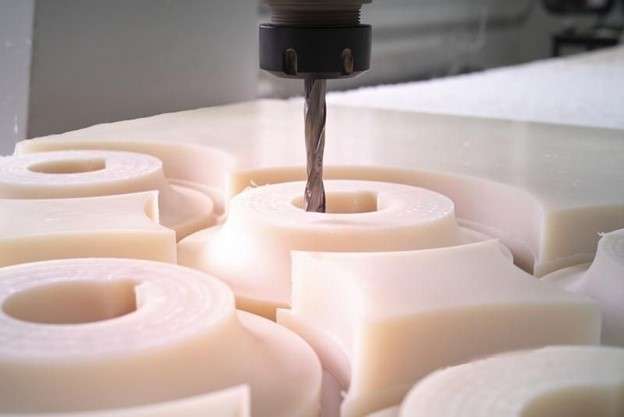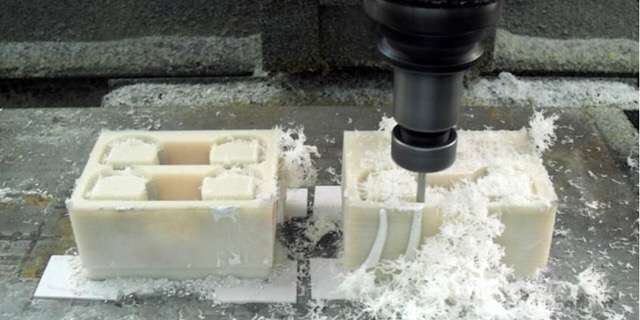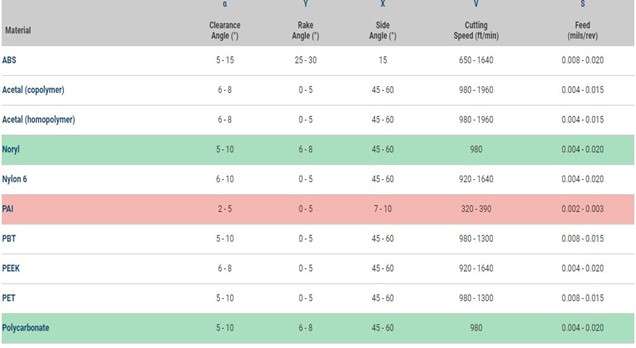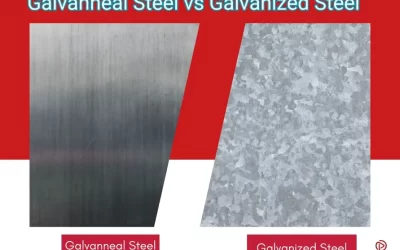
CNC machining of thermoplastic
You might already be familiar with two types of plastics: thermoset and thermoplastic. The fundamental difference is that thermoset plastics cannot be re-molded after heating, while thermoplastics can be melted and re-molded.
Plastics are the essential parts of CNC materials, and various plastics are available for CNC machining projects. Both thermoset and thermoplastics are compatible with CNC machining operations, although we will discuss thermoplastics in this article, including properties, machining process, advantages, and applications.
What is Thermoplastic?
Thermoplastics are mixtures of polymer resins that do not exhibit changes in properties when heated. They become softer when heated and harder to cool. Thermoplastic can be remolded after melting, retaining all original physical, mechanical, and chemical qualities.
Thermoplastics offer mechanical strength, impact resistance, machinability, corrosion resistance, chemical inertness, and many other beneficial properties.
Common thermoplastics in CNC machining
Different thermoplastics are used in CNC machining projects based on the required specifications and intended use of the parts. Each thermoplastic has a few unique benefits and qualities to offer. The thermoplastics most frequently used in CNC machining are ABS, PMMA, PVS, Acrylic, Polycarbonate, Polystyrene, and Polyurethane.
Related resources:
ABS CNC Machining: Everything You Need to Know
5 Features of Processing Polyurethane on CNC Machines
Properties of Thermoplastics
Thermoplastics are suitable CNC materials for many applications; they do not react with acidic or alkaline chemicals and provide excellent strength, toughness, and durability. Let’s discuss the various thermoplastics’ properties in more detail.
- Mechanical strength
Thermoplastics have lower strength than most metals and alloys, but their lightweight nature makes them comparable with metals. Often, thermoplastics are reinforced with fiber and glass to increase their strength for CNC machining projects. However, this also depends on the specific type of thermoplastics. For example, PE offers low mechanical strength, while ABS and Acrylic provide high strength.
- Impact strength
Thermoplastics can withstand impact loads without losing their physical & mechanical properties. Thermoset plastics could be fractures on impact loads, while thermoplastics need high energy for fracture phenomena.
POM Machining: Polyoxymethylene (POM) is the best thermoplastic for high-impact strength. It performs well under repeated impact loadings. Additionally, the temperature of the operating environment affects the impact strength of any thermoplastic.
- Hardness
Thermoplastics have decent hardening properties. They prevent cracking and chipping during CNC machining operations. Additionally, CNC-machined thermoplastic parts become highly abrasion-resistant.
- Chemical Compatibility
Chemical compatibility is a key characteristic that makes thermoplastics superior to many CNC machining procedures. It does not react with harsh chemicals (acids & alkalis).
Some thermoplastics also exhibit natural lubricities like Nylon, Acrylic, and Delrin. The slippery natures of these plastics are beneficial in various food-processing & medical applications.
- Recyclability
Thermoplastics are entirely recyclable and can be recreated by melting and shaping them in a mold. The recycled plastics retain all their original properties.
- Moisture & electrical insulation
It does not absorb moisture and shows excellent waterproofing. Therefore, thermoplastics are widely beneficial for various marine and other water-proof applications.
Thermoplastics can resist high electrical voltage without deformation. It is the perfect choice for electrical insulation in electrical and electronics applications.

Properties of thermoplastics (Thermoplastics – Physical Properties, 2005)
How to Choose the Right Thermoplastics for CNC Machining?
The choice of thermoplastic for your CNC machining projects depends on several factors, such as required properties, specifications, features, intended application, and cost.
The first step involves the identification of required properties for particular applications. List all the physical, mechanical, and chemical properties essential for the functionality of the desired part. In addition, it is also crucial to consider operating conditions and performance while listing the properties.
- ABS
ABS CNC machining: ABS is a strong, rigid material with outstanding impact resistance. After CNC processing, it leaves a smooth surface. If further finishing is essential, the surface can be finished with a metallization and electroplating approach. ABS is used in automotive, aerospace, electronics, and many other industries.
- Delrin
Machining Delrin: Delrin is well known for its lightweight, mechanical strength, chemical compatibility, and electric & thermal insulation. It has applications in various industries, such as automotive, home appliances, electronics, and .fitting
- PMMA
PMMA is a rigid and transparent thermoplastic used in CNC machining operations instead of glass.
It provides high chemical inertness, wear resistance, weather resistance, and impact strength. PMMA could be the best material choice for windows, automotive parts, drug testing devices, architectural parts, and electronics components.
- Polycarbonate
Polycarbonate is a complex, challenging, and transparent engineering thermoplastic that maintains high dimensional stability with CNC machining processes. Unlike other thermoplastics, PC offers low scratch resistance and chemical compatibility. It plays a significant role in automobiles, lighting, optical instruments, electronics, and other industries.
- PVC
PVC is one of the widely used thermoplastics in CNC machining projects. It is a rigid, lightweight, weather-independent, and strong material with intrinsic flame-retardant properties. PVC is used in many applications, including plumbing, medical components, automotive interiors, footwear, and packaging.
Selection of tool path
After selecting the material, fixing the tool path according to the 3D model is crucial. The correct tool path ensures the shortest route and quality of surface finishing. Using CAM software can be the best approach to choosing the tool path.
Try Prolean Now!
Machining Process of Thermoplastics

CNC machining of ABS
Thermoplastics can be machined with general CNC machining tools made of hard steel. The feed rate and cutting speed are two significant variables affecting machining quality. However, a fine, C-2 grade carbide tool might be needed for turning thermoplastics.
The machinability of thermoplastics also influences the quality of the machined part. It is necessary to consider this before jumping into the machining step. The machining conditions for various thermoplastics are listed in the table below (Plastic Turning Machining Guidelines, 2020)

Turning variables for thermoplastics
This table shows that every thermoplastic has distinct machining parameters, such as clearance angle, rake, angle, cutting speed, and feed rate. Each thermoplastic has a different strength, hardness, and machinability degree.
Surface Finishing options
CNC-machined parts of thermoplastics contain a satisfactory as-machined surface finish. However, further surface-finishing processes might be required in many applications. Surface finishing of thermoplastic parts results in a smooth and shiny surface, eliminating tool marks, burrs, and small chips.
Bead blasting, deburring, polishing, metallization, and etching are the frequently used surface finishing approaches for CNC-machined thermoplastic parts. However, depending on the particular type of thermoplastic, special surface finishing can be employed for better results.
Related:
Top 5 Ways for Metal Engraving in 2023
For instance, flame polishing creates a shiny and smooth surface on acrylic objects by applying medium-flame heat to the surface.
Advantages
CNC machining of thermoplastics offers various advantages, such as accuracy, complex shapes, cost-effectiveness, and many more.
- Accuracy
Thanks to their machinability, thermoplastics can be machined with tight tolerances. Advanced CNC machines can create thermoplastic parts with tolerances as low as ±0.002 mm. The high degree of accuracy also facilitates the large-volume production of identical thermoplastic parts.
- Intricate shapes
Thermoplastics can be utilized to make intricate shapes using CNC machining, which is challenging to create with other plastics and techniques. The computer-controlled mechanism of CNC technology allows for the movement of the tool to be dictated for precise machining.
- Cost-effectiveness
The high production speed and low cost of thermoplastics make the process cost-effective. Compared with metal and alloys, thermoplastic parts are less costly to create with CNC machining.
- Smooth finish
Thermoplastic parts created with CNC machining leave a smooth surface compared to other manufacturing approaches, such as injection molding. In addition, It does not leave any rough edges.
More resources:
Cost Reduction tips for CNC machining
Why is CNC Machining Better than Injection Molding for Thermoplastic Prototyping?
CNC Machining: Best Approach for Manufacturing
Applications
Various thermoplastics are used in a range of industries after processing with CNC machining. Their lightweight nature, strength, and toughness make them ideal choices for automotive, aerospace, electrical, electronics, piping, home appliances, and many more industries.
| Automotive & aerospace | Fire extinguishers, turbine engines, seat covers, seat belt mechanisms, fuel rails, control valves, HVAC parts, clips, fuel tanks, bushings, aerospace engine parts, and aircraft exterior components. |
| Medical | Graft material in surgical interventions, dental instruments, Screws and plates, Medication pumps, endoscopes, Insulin pens, Dialysis machine parts, and many more. |
| Electrical & electronics | Wire insulators, trim circuits, electronic housing, control panels, keyword keys, connectors jacks, Convoluted tubing |
| Food processing | Packaging, food processors, and more. |
| Pipes and fittings | Water-tight seals, vacuum construction, pipes, and many more. |
| Others | Music instruments, sports equipment, kitchenware, shipbuilding, oil & gas, parts for the defense industry, and many more. |
Related Resources:
CNC Machining for Automotive Industry: Applications and Advantages
CNC Machining In Medical Prototyping and Mass-production
Food-processing Prototypes: Material, Steps, and Manufacturing Consideration
Machining Robotics: Precision and Speed
Is the thermoplastics go-to option for CNC prototyping?
Thermoplastics are lightweight and low-cost materials with high machinability, strength, toughness, impact resistance, wear resistance, and corrosion resistance. These properties make them ideal for prototyping parts or products for various industries, including automotive, aerospace, medical, electronics, oil and gas, and food processing.
A thoughtful prototyping process demands quick production, low cost, and accuracy. Plastic CNC machining of thermoplastics addresses all these requirements.
Conclusion
Thermoplastics work extremely well with CNC machining processes, which are helpful for prototype and high-volume manufacturing. The versatile physical, mechanical, and chemical properties are beneficial for a range of applications.
Prolean has over a decade of experience with thermoplastic mass production and prototyping. We can create highly accurate parts with 20+ plastic options. If you need Plastic machining for your project, send us your design, and your parts will be delivered to your door within a few days.
FAQ’s
What are the critical properties of thermoplastics?
Thermoplastics are low-cost and highly machinable materials with excellent strength, toughness, impact resistance, and wear resistance. ABS, PMMA, PVS, Acrylic, Polycarbonate, and Polystyrene are frequently used thermoplastics in CNC machining.
What are the CNC machining conditions for thermoplastics?
CNC machining of thermoplastics produces the best results with high cutting speed, medium feed rate, hard-steel tools, and appropriate tool positioning (depending on the specific type of thermoplastic).
What are the applications of thermoplastic CNC machining?
CNC-machined thermoplastic parts are used in the automotive, aerospace, medical, defense, oil & gas, food processing, electronics, and electrical industries.
What are the advantages of thermoplastic CNC machining?
CNC machining of thermoplastics offers high accuracy, complexity, repeatability, cost-effectiveness, and many more advantages.
Bibliography
- (2020). Plastic Turning Machining Guidelines. Curbell Plastics, from https://www.curbellplastics.com/.
- (2005). Thermoplastics – Physical Properties. from https://www.engineeringtoolbox.com/.




0 Comments